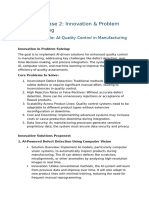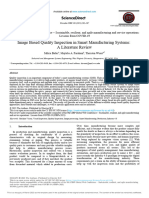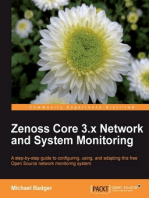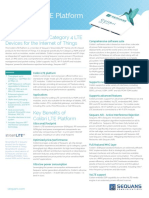Automated IoT Based Quality Inspection System Using Computer Vision
Uploaded by
Pranoy MukherjeeAutomated IoT Based Quality Inspection System Using Computer Vision
Uploaded by
Pranoy MukherjeeProject Title:
Automated IoT Based Quality Inspection System Using Computer Vision
Project Overview:
The project's goal is to create an automated quality inspection system that checks
produced parts for flaws and irregularities using deep learning and computer vision. By
identifying surface flaws, dimensional errors, and texture irregularities in real time, the
technology will drastically cut down on the amount of manual inspection work required.
Objectives:
1. Develop a computer vision-based inspection system to enhance accuracy and
e iciency in quality control.
2. Implement deep learning algorithms to detect common manufacturing defects
such as cracks, scratches, and dimensional deviations.
3. Integrate the system with existing manufacturing workflows for real-time monitoring.
4. Provide a user-friendly interface for visualizing inspection results and generating
reports.
Motivation:
Manual inspection of manufactured parts is labor-intensive and prone to human error. An
automated inspection system would enhance consistency and reduce quality control
costs. This project aligns with your interests in manufacturing automation and AI
applications.
Methodology:
1. Data Acquisition:
o Capture high-resolution images of manufactured parts using industrial
cameras.
o Develop a controlled lighting setup to minimize reflections and shadows.
2. Image Processing:
o Preprocess the images to enhance features (e.g., edge detection, noise
reduction).
o Implement techniques like thresholding and contour detection for basic
defect identification.
3. Defect Detection and Classification:
o Train deep learning models (e.g., CNNs) using datasets of defective and non-
defective parts.
o Use frameworks like TensorFlow or PyTorch for model development.
o Integrate OpenCV for real-time image processing and analysis.
4. System Integration:
o Implement a Raspberry Pi 4 as the primary processing unit for image
capture and analysis.
o Integrate the system with a centralized platform for monitoring and data
logging.
5. User Interface:
o Develop a web-based dashboard using React and Node.js for real-time
visualization and reporting.
o Display defect statistics, image samples, and inspection logs.
Tools and Technologies:
Programming Languages: Python3, C++
Libraries/Frameworks: OpenCV, TensorFlow, PyTorch, React, Node.js
Hardware: Raspberry Pi 4, Industrial Cameras
Design Tools: SolidWorks for fixture and camera mount design
Simulation and Prototyping: MATLAB for initial algorithm testing
Expected Outcomes:
A fully automated system capable of real-time quality inspection.
A modular and scalable solution that can be adapted to di erent manufacturing
environments.
An interactive dashboard for visualization and analytics.
You might also like
- Deep Learning Based Computer Vision SystNo ratings yetDeep Learning Based Computer Vision Syst10 pages
- Previous AI Projects - 10 Sample ProjectsNo ratings yetPrevious AI Projects - 10 Sample Projects14 pages
- AI Driven Industry 4 0 Advancing QualityNo ratings yetAI Driven Industry 4 0 Advancing Quality17 pages
- Smart Camera: Revolutionizing Visual Perception with Computer VisionFrom EverandSmart Camera: Revolutionizing Visual Perception with Computer VisionNo ratings yet
- Enhancing Quality Control in Industry 4.0 Advanced Image Processing For Automated Defect DetectionNo ratings yetEnhancing Quality Control in Industry 4.0 Advanced Image Processing For Automated Defect Detection8 pages
- Project Synopsis_ Wrong Object Insert Detection System - Google DocsNo ratings yetProject Synopsis_ Wrong Object Insert Detection System - Google Docs3 pages
- Machine Learning with Python: A Comprehensive Guide with a Practical ExampleFrom EverandMachine Learning with Python: A Comprehensive Guide with a Practical ExampleNo ratings yet
- [IJCST-V13I2P6]:Kishore S,Akilesh G,Kugan K,Bharathi VNo ratings yet[IJCST-V13I2P6]:Kishore S,Akilesh G,Kugan K,Bharathi V4 pages
- Computer Application Lab Project ProposalNo ratings yetComputer Application Lab Project Proposal3 pages
- Printed Circuit Board Defect Detection Using MachiNo ratings yetPrinted Circuit Board Defect Detection Using Machi9 pages
- Real-Time Industrial Vision System For Automatic Product Surface InspectionNo ratings yetReal-Time Industrial Vision System For Automatic Product Surface Inspection5 pages
- An-embedded-machine-vision-system-for-an-in-line-quality_2020_Procedia-ManufNo ratings yetAn-embedded-machine-vision-system-for-an-in-line-quality_2020_Procedia-Manuf11 pages
- 6th_sem_FIRST_review[1].Pptx - Read-OnlyNo ratings yet6th_sem_FIRST_review[1].Pptx - Read-Only13 pages
- An Industrial Vision System For Surface Quality Inspection of Transparent PartsNo ratings yetAn Industrial Vision System For Surface Quality Inspection of Transparent Parts14 pages
- Smart Manufacturing Using IOT: Mateen Majgaonkar, Payal Yadav Hardik Bamb, Pushkaraj Dhole Avinash PlaveNo ratings yetSmart Manufacturing Using IOT: Mateen Majgaonkar, Payal Yadav Hardik Bamb, Pushkaraj Dhole Avinash Plave3 pages
- Aphelion Software: Unlocking Vision: Exploring the Depths of Aphelion SoftwareFrom EverandAphelion Software: Unlocking Vision: Exploring the Depths of Aphelion SoftwareNo ratings yet
- Improving Data Analysis in The Internet of Things Using Computer Vision TechniquesNo ratings yetImproving Data Analysis in The Internet of Things Using Computer Vision Techniques6 pages
- AR-VR For Manufacturing and Automotive IndustryNo ratings yetAR-VR For Manufacturing and Automotive Industry4 pages
- Vision Based Defect Detection Algorithm Devolopment For Mas Pad Printing MachineNo ratings yetVision Based Defect Detection Algorithm Devolopment For Mas Pad Printing Machine93 pages
- Wiley S Mathematics For IIT JEE Main and Advanced Calculus Vol 3 Maestro Series Dr. G S N Murti Dr. K P R Sastry75% (4)Wiley S Mathematics For IIT JEE Main and Advanced Calculus Vol 3 Maestro Series Dr. G S N Murti Dr. K P R Sastry625 pages
- (Mathematics for IIT JEE Main and Advanced Algebra) Dr. G S N Murti Dr. U M Swamy - Wiley s Mathematics for IIT JEE Main and Advanced Algebra Vol 1 Maestro Series Dr. G S N Murti Dr. U M Swamy-Wiley (.pdf83% (6)(Mathematics for IIT JEE Main and Advanced Algebra) Dr. G S N Murti Dr. U M Swamy - Wiley s Mathematics for IIT JEE Main and Advanced Algebra Vol 1 Maestro Series Dr. G S N Murti Dr. U M Swamy-Wiley (.pdf504 pages
- WWW - Jeeneetbooks.in Disha MathematicsNo ratings yetWWW - Jeeneetbooks.in Disha Mathematics2,146 pages
- WWW - Jeeneetbooks.in Disha 43 Years Jee Advanced Chemistry100% (2)WWW - Jeeneetbooks.in Disha 43 Years Jee Advanced Chemistry1,773 pages
- WWW - Jeeneetbooks.in Disha 43 Years JEE Advanced Physics100% (1)WWW - Jeeneetbooks.in Disha 43 Years JEE Advanced Physics656 pages
- Artificial Intelligence in Smart Agriculture AppliNo ratings yetArtificial Intelligence in Smart Agriculture Appli24 pages
- Toward An Applied Cyber Security Solution in Iotbased Smart Grids An Intrusion Detection System Approachsensors SwitzerlandNo ratings yetToward An Applied Cyber Security Solution in Iotbased Smart Grids An Intrusion Detection System Approachsensors Switzerland22 pages
- An Intelligent Controller For Smart HomeNo ratings yetAn Intelligent Controller For Smart Home4 pages
- The Application of New Technologies in Marketing With Review On Marketing of Things Primjena Novih Tehnologija U Marketingu S Osvrtom Na Marketing StvariNo ratings yetThe Application of New Technologies in Marketing With Review On Marketing of Things Primjena Novih Tehnologija U Marketingu S Osvrtom Na Marketing Stvari12 pages
- Distributed Fault Detection, Isolation, and Restoration (FDIR) Technique For Smart Distribution SystemNo ratings yetDistributed Fault Detection, Isolation, and Restoration (FDIR) Technique For Smart Distribution System5 pages
- Why Learn About Networks and Cloud Computing?No ratings yetWhy Learn About Networks and Cloud Computing?87 pages
- A.G. Patil Polytechnic Institute, Solapur: PPT On Iot Based Home Automation SystemNo ratings yetA.G. Patil Polytechnic Institute, Solapur: PPT On Iot Based Home Automation System17 pages
- BTech. 4th Year - Computer Science and Engineering - Internet of Things - 2023-24No ratings yetBTech. 4th Year - Computer Science and Engineering - Internet of Things - 2023-2420 pages




































































































